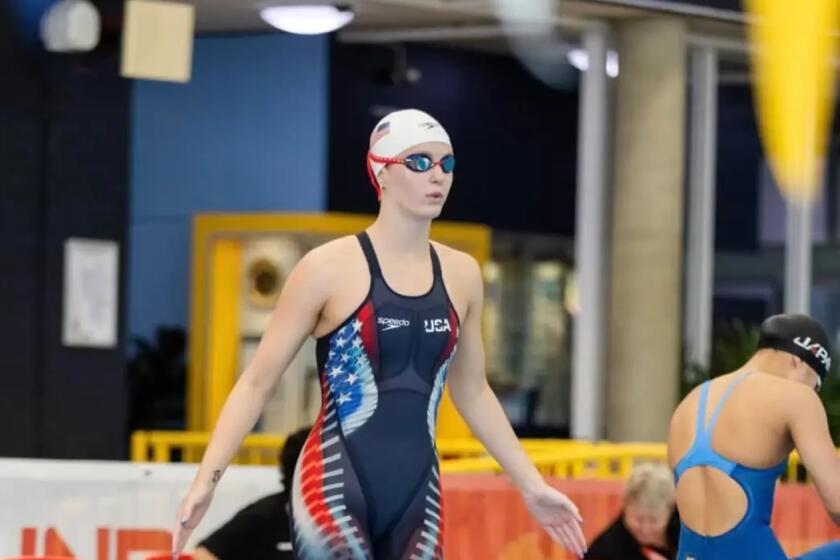Indy Speed Rarely Kills as in Past
- Share via
In 75 years of 500-mile racing, 52 men have died--or suffered fatal injuries--in a race car at the Indianapolis Motor Speedway.
That’s not that bad when you consider there have been more than 2,500 drivers and several hundred mechanics in the 500-mile race.
That doesn’t even put it neck and neck with the Hollywood Freeway.
But you have to bear in mind these were the finest drivers in the world. None of them were drunk, all could see perfectly. None of them were lost and consulting a lap map for directions. Their cars had to pass the most rigid inspection, the tires were always brand new, the brake linings not worn. There wasn’t any traffic coming the other way. The radio wasn’t on, the weather was always perfect or you weren’t out there, you didn’t have to watch out for cops, pedestrians, road construction, streetcars or railroad crossings. If the road got so much as gum wrapper on it, they stopped and vacuumed it.
You could go as fast as you’d want. And therein lies the rub. Cars might be built to go 240 m.p.h. People aren’t.
But it seemed the faster men and cars went, the safer it got.
It used to be in this country that one out of every three men who climbed in a race car died in a race car. And that was when 100 m.p.h. was considered scorching.
The last fatality on the Speedway before this year was 10 years ago. You will find no comparable span of time between fatal accidents. The Speedway served up an annual fatality. Some years--1933, for instance--there were as many as five.
Many of these accidents took place when the average race speed was 104 m.p.h. In the years no fatalities occurred, it ranged from 185 m.p.h. to 162. Qualifying speeds in the multiple-accident years were 116 m.p.h. This year, they reached 230 m.p.h.
Death seemed finally to be taking this holiday. It defied logic. It was eerie. The Indy track was still only 50 feet wide. They still had those unforgiving concrete walls. Even if the cars had changed, drivers hadn’t.
There were something like 14 crashes at the Speedway this year. Some of them lit the sky. Car parts flew through the air, wheels soared skyward. Rick Mears slid along the wall upside down with a disintegrating front end and a car churning like a washing machine. But, incredibly, he walked away. And got into another race car. Driver after driver walked away all month.
Until Friday. Edward Jovy Marcelo, a 27-year-old rookie from the Philippines, joined the ghostly parade of those who didn’t.
Death is capricious. Marcelo lost his life driving 173 m.p.h. Drivers going 230 climbed safely out of their crashes. Death doesn’t care if you are going fast or slow, racing, practicing or qualifying.
It is uncanny how many times--19 to be exact--the words in practice appear in the roll call of the fatally injured. Eight of the last 11 killed at the Speedway died in practice. To die at 172 m.p.h. is the ultimate irony. Indy drivers come into the pits faster than that. It is like that soldier killed in the war reaching for a butterfly.
Any death is too many. But the death of an obscure rookie driver from Manila does not command the media attention the death of an icon of the sport would.
The icons of the sport have been spared in large part. The last marquee name to get killed at Indy was Eddie Sachs in 1964. Foyt, the Unsers (one brother did die in a race car-- in practice ), the Andrettis, Mears, Fittipaldi, Sullivan, Rahal elude the ultimate black flag whether through superior driving skill, experience or simple intelligence. Indianapolis is lucky. If A.J. Foyt were to die in a race car, the hue and cry of those who would have the sport abolished would be deafening.
Fourteen crashes in two weeks would seem to be trying to tell the track something. The old saying goes: To finish first, first you have to finish. The tubs, or cockpits, surrounding the driver might be all but impregnable, cars might be constructed to break away like sets for movie fights--but people can’t break away. It’s nice to try to go fast enough to arrive at Victory Lane. But you don’t want to say, “I’ll give it my all” or “I’ll die trying.” Because you might.
More to Read
Go beyond the scoreboard
Get the latest on L.A.'s teams in the daily Sports Report newsletter.
You may occasionally receive promotional content from the Los Angeles Times.










